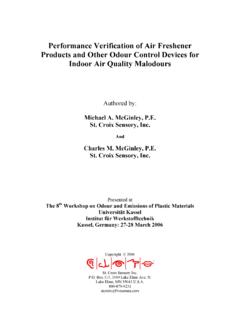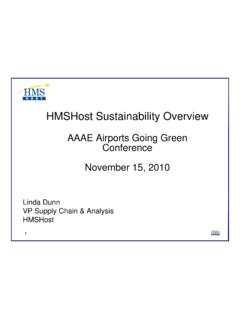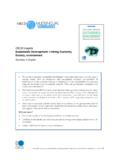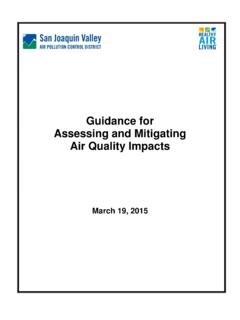Transcription of OVERVIEW OF THE CLEAN AIR ACT AMENDMENTS OF 1990 - GCADA
1 OVERVIEW OF THE CLEAN AIR ACT AMENDMENTS OF 1990 In response to increase scientific evidence of significant ozone depletion, the land mark international environmental agreement, the Montreal Protocol on Substances that Delete the ozone Layer, was signed in September 1987. The original Protocol called for 50 percent reduction in CFC s by the year 1998. The discovery of seasonal ozone hole over Antarctica highlighted the need for more stringent measures. In June 1990, the Protocol was amended to comply phaseout production CFC s halons (used in fire extinguisher by the year 2000. In November 1992, in response to scientific findings indicted that ozone depletion was more severe than anticipated, the parties to the Montreal Protocol voted to accelerate the phaseout to the end of 1995. Currently, 132 nations, representing over 95 percent of the worlds consumption of CFC s are parties to the Protocol.)
2 In addition to the phase out of ozone -depleting substances, title VI includes provisions to reduce emissions of all ozone -depleting substances. Section 608 contains requirements for a lowest achievable level of emissions of the controlled substances during use and disposal of appliances and industrial process refrigeration and bans on intentional venting at services and disposal. The requirements for auto technicians and the regulations they must follow when servicing an A/C unit are in Section 609 of the Act. Section 609 of the CLEAN Air Act of 1990 establishes an important new statutory structure to control the release of refrigerants from motor vehicle air conditioners into the atmosphere. After January 1, 1992, any person repairing or servicing motor vehicle air conditioners for consideration must properly use refrigerant recycling equipment that has been approved by the EPA.
3 All such persons must be properly trained and certified. To obtain your certification, you must read and study the following booklet, including completing the test at the end of the booklet. The test will consist of 25 questions, and will be on the material covered in the booklet. You cannot miss more than five questions to pass. Should you have questions about the booklet, please call the Greater Cleveland Automobile Dealers' Association (328-1500). WHAT IS THE ozone ozone is formed when ultraviolet radiation from the sun reacts with oxygen molecules which causes them to split apart into two oxygen atoms. These separated atoms then combine with other oxygen molecules (O2) to form ozone (O3), which contains a total of three oxygen atoms. ozone is a pungent gas that has a close chemical relationship to molecular oxygen.
4 About 90 percent of the earth s ozone is located in a layer far above the earth s surface in a region known as the stratosphere. This natural layer acts as a shield against ultraviolet radiation. Concern about possible depletion of the ozone layer from CFC s was first raised in 1974 with publication of research which theorized that chlorine released from CFC s could migrate to the stratosphere and destroy ozone molecules. (Molina and Rowland, 1974). Some of the CFC s have an atmospheric lifetime of more than 120 years and as a result, they rise slowly to the stratosphere where the Suns radiation strikes them, releasing chlorine. Once freed, the chlorine acts as a catalyst repeatedly combining with and breaking apart ozone molecules. If ozone depletion occurs, more UV radiation penetrates the earth s surface.
5 Moreover, because of the long atmospheric lifetimes of CFC s, it would take many decades for the ozone layer to return to past concentrations. HOW IT EFFECTS THE ENVIRONMENT The ozone layer shielding the earth from much of the damaging part of the sun s radiation and is a critical resource safeguarding life on this planet. Should the ozone layer be depleted, more of the sun s damaging rays would penetrate to the earth s surface. It is believed that for each one percent depletion exposure to damaging ultraviolet radiation would increase by to 2 percent. The Environmental Protection Agency s (EPA) assessment of the risks from ozone depletion focused on the following areas: *Increases in skin cancers *Suppression of the human immune response system *Increases in cataracts *Damage to crops *Damage to aquatic organisms *Increases in ground level ozone *Increased global warming HOW IT EFFECTS THE HUMAN HEALTH Under current atmospheric conditions, the greater the distance from the equator, the greater the effectiveness of the ozone layer as a shield.
6 As a result, people who live further north are exposed to less damaging UV radiation than those residing closer to the equator. Not surprisingly, the chances of getting skin cancer follow the same gradient; the closer to the equator, the greater the risk. Three distinct types of the skin cancer would increase if the ozone layer is depleted. Basal and squamous cell skin cancers, the two most common types, affect about 500,000 people annually in the United States alone. If detected early, these cancers are treatable. Even so, approximately 1 percent of cases result in premature deaths. Malignant melanoma is far less common but substantially more harmful. About 25,000 cases now occur annually resulting in 5,000 deaths. Cataracts cloud the lens of the eye, thus limiting vision. Although cataracts develop for a variety of reasons, scientific evidence supports the conclusion that increased exposure to UV radiation would increase the number of people experiencing this eye disorder.
7 Based on epidemiological studies, if current trends in the use of ozone depleting gases continued, the number of cataract cases would increase by 16 million (for the population alive today or born before 2075). Suppression of the immune system is another possible threat to human health resulting from ozone depletion. HOW IT EFFECTS PLANT & MARINE LIFE Crop and other land based ecosystems could also be adversely affected by increased exposure to UV radiation. In studies of the greenhouse effect, approximately 65 percent of the crops exposed to elevated levels of UV radiation proved sensitive. Certain marine organisms, particularly phytoplankton, may be sensitive to increased exposure to UV radiation because they spend much their existence near the surface of the water. Other Considerations: Ground Level ozone - ozone depletion in the stratosphere would increase the rate of formation of ground level (tropospheric) ozone , due to higher levels of UV radiation, a major component of what is commonly called smog.
8 Degradation of Polymers - ozone depletion would accelerate the breakdown ( chalking, yellowing, and cracking) of plastics used in outdoor applications. Climatic Changes - CFC s are greenhouse gases and thus would contribute to global warming and rising sea levels. THE GLOBAL CONCERN ON THE ozone Unlike other environmental issues, stratospheric ozone protection is a global concern. CFC s and halons are used by most industrialized nations, and, given their long atmospheric lifetimes, they become widely distributed over time. As a result, the release of these chemicals in one country could adversely affect the stratosphere and therefore the health and welfare of other countries. Many developed and developing countries produce CFC s and halons. Most use the chemicals in a variety of different products.
9 The United States is one of the largest consumers of the world s CFC s. Other nations are also significant users. Therefore, to protect the ozone layer from the damages that may be caused by CFC s and halons, an international solution is critical. OPTIONS OF TOPPING OFF LEAKING SYSTEM Since Section 609 of the Federal CLEAN Air Act of 1990 came into affect, their has been some confusion on whether it is legal to top of a leaking air conditioning system. Although the EPA encourages, but does not mandate, leak detection and repair of air conditioners systems, it is essential that consumers realize that, in most states and localities, they have the option to top off their air conditioning systems with freon. THE RECYCLING CONCEPT FIELD STUDY: Due to the serious nature of the ozone depletion issue, industry efforts were immediately directed toward determining if CFC s used in the mobile air conditioning service industry could be recycled.
10 During the summer of 1988, the EPA, with the support of the Mobile Air Conditioning Society (MACS) initiated a sampling program of used refrigerant from 227 vehicles from 4 regions of the country. These vehicles included properly operating systems, failed compressors, low mileage vehicles, and vehicles with over 100,000 miles. The chemical analysis of the removed refrigerant indicated a low amount of contamination. From the field study results, the task force established specifications for recycled refrigerant and requested the world auto manufacturers to approve the level of purity in December, 1988. Many automobile and truck manufacturers have accepted recycled CFC-12 for service and warranty repairs. SYSTEM CONTAMINANTS: Data gleaned from the field study of CFC-12 from mobile air conditioning systems identified moisture, refrigerant oil and non-condensable gases (air) as contaminants in used refrigerant that could affect system performance and life.










